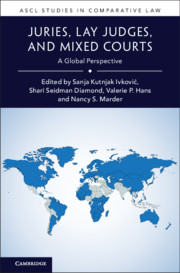Book contents
- ASCL Studies In Comparative Law
- Juries, Lay Judges, and Mixed Courts
- Copyright page
- Contents
- Editors
- Contributors
- Acknowledgments
- 1 Introduction
- Part I Advances in Lay Participation
- Part II Enduring Systems of Lay Participation
- Part III Challenges to Lay Participation in Law
- Part IV Global Perspectives on Lay Participation
- Name Index
- Subject Index
- References
1 - Introduction
Published online by Cambridge University Press: 03 August 2021
- ASCL Studies In Comparative Law
- Juries, Lay Judges, and Mixed Courts
- Copyright page
- Contents
- Editors
- Contributors
- Acknowledgments
- 1 Introduction
- Part I Advances in Lay Participation
- Part II Enduring Systems of Lay Participation
- Part III Challenges to Lay Participation in Law
- Part IV Global Perspectives on Lay Participation
- Name Index
- Subject Index
- References
Summary
Many countries around the globe rely on ordinary citizens, untrained in the law, to decide the guilt or innocence of their fellow citizens. Some countries use all-layperson juries, while others use mixed tribunals or mixed courts in which professional judges and lay citizens work together to decide a case. Still other countries use lay magistrates or lay judges working alone or on panels. This book provides a view of the different forms of lay participation and the ways in which they are evolving. It offers a comprehensive picture of how some countries have made recent and remarkable advances toward lay decision-making, while others have a long-standing form of lay participation that is well accepted in that country. Still other countries have faced challenges with lay participation and have opted for limiting the scope of lay legal decision-making or even abolishing it. The organization of this book illustrates that lay participation in a country is not fixed in stone; lay participation is being advanced, reinforced, or replaced in countries around the world. These shifting responses to lay participation suggest the prime importance of stepping back and taking a global perspective.
Keywords
- Type
- Chapter
- Information
- Juries, Lay Judges, and Mixed CourtsA Global Perspective, pp. 1 - 22Publisher: Cambridge University PressPrint publication year: 2021
References
- 1
- Cited by



